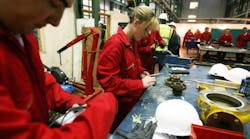Concerns about the skills gap in manufacturing may be easing somewhat, according to a PwC/Manufacturing Institute survey of 120 U.S. manufacturers that was released today. But the need for advanced manufacturing skills is still great.
Here are some of the findings in the study, Upskilling Manufacturing: How Technology Is Disrupting America's Industrial Labor Force.
Skills shortages not uniformly felt: 33% of manufacturers say they have no or only a little difficulty in hiring talent. Forty-four percent have “moderate difficulty.”
Yet manufacturing job openings are still far outnumbering hires. In July 2015, there were 388,000 openings and 294,000 hires, according to the Bureau of Labor Statistics (BLS). Other industries did not have such a dramatic gap between job postings and hires.
Some are worried: Thirty-one percent of those surveyed say they don’t see a skills shortage now, but anticipate one developing in the next three years, while 26% say the shortage has already peaked and better days are ahead. Another 29% say the shortage exists and will only increase in the next three years.
Most prefer in-house: The most common strategy to upskill employees is to train in-house, followed by recruiting local STEM students and offering outside vocational training.
Robots aren’t stealing jobs: 37% of respondents believe that the adoption of advanced manufacturing technologies will result in their hiring more employees; 45% said that will have no impact on hiring; 17% said they will hire fewer employees.
Still, some see increased automation hindering manufacturing job growth. While the 12.3 million manufacturing jobs today are more than in 2010, the depths of the recession, that number is still 14% less than the 14.4 million jobs a decade ago.
“We still don’t really know how to solve the problem of jobs being lost through automation,” Daniel Araya, a fellow at the Hult Global Center for Disruptive Innovation, said in the study. “Automation could cause a very high level of social dislocation, and that’s something we really need to take seriously and resolve.”
Advanced technology changing job requirements, descriptions: Nearly 3/4s of non-shop-floor manufacturing jobs go to candidates with four-year or advanced degrees.
Only 13% of manufacturers said they’ve had no difficultly finding talent for advanced manufacturing jobs (3D printing, IoT, robotics, virtual/augmented reality).
Manufacturing wages have steadily increased, as has productivity: Labor output was over 110 units per hour in 2016, compared to 75 in 2002 and 50 in 1989, according to the BLS. Average wages have risen from $20.69 in 2006 to $25.49 in 2015.
Registered apprenticeships have increased: According to the U.S. Department of Labor, there were about 450,000 registered apprenticeships in 2015, up from 350,000 in 2011.



